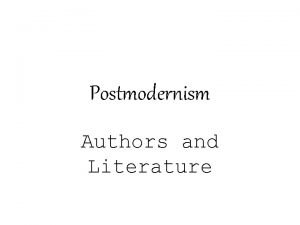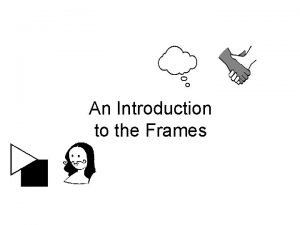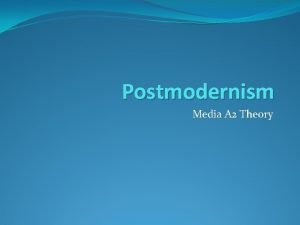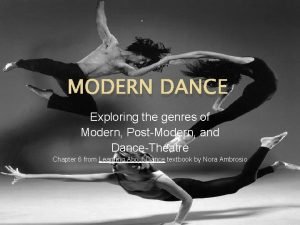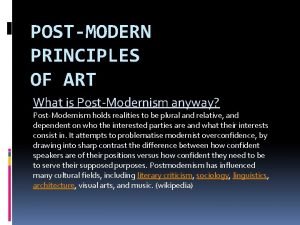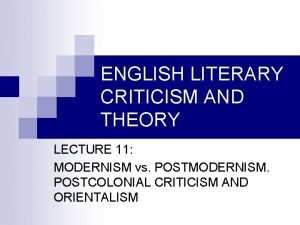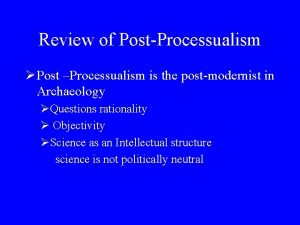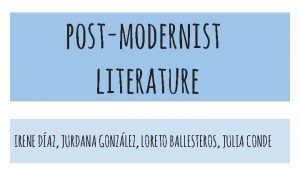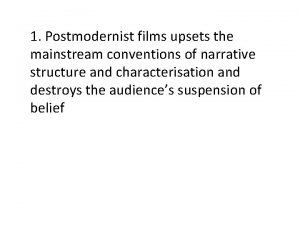POST MODERN YOUTH A look a postmodernist perspective














- Slides: 14

POST MODERN YOUTH A look a post-modernist perspective and its views on youth sub-culture.

Starter List Leisure activities you have taken part in

Youth is all about style Who has style and who doesn’t Describe them !!

Theoretical re-cap Structural theories are Macro – they consider the big structures which determine how society works – social class, gender, functions of institutions like marriage or justice system. Social Action theories are Micro – they consider the interactions between people, how people are labelled by others Post Modernism does not fit into either of these because they believe that society is different now!

Post-modernism re-cap It is not possible to have an overriding theory of society things are too fluid and diverse. We live in a media saturated society which makes it difficult to see what reality really is. We can make choices about our identity and we can buy identities through consumerism. We can move in and out of identities as it suits us. Evaluation – is this true?

Post-Modernism and Youth Post modernists argue that since the 1990 s youth style and culture has become increasingly diverse and fragmented. They argue that sub-cultures no longer necessarily form around commonalities like gender, class or ethnicity and that styles based around particular music or clothing tastes have broken down.

Tribalisation Refers to the breaking down of associations based on gender, ethnicity or class and the recomposition of associations based on ‘tribal’ identities which are mainly consumer and leisure orientated. – it is less a question of belonging to a gang, a family or a community than of switching from one group to another. Maffesoli (1996)

NEO Tribes This is what Bennett (1999) called a Neo Tribe. Youth is a social construction and in recent years has become elongated. Young people therefore may pick and choose their associations due to a need to find satisfying leisure activities. They are not identities that are fixed or rooted in particular gender, class etc they are loose associations which can change. Examples ………………. .

Club Culture Clubbers in the late 80’s and early 90’s based on collective experience of dance not based on any particular class, gender etc. Researched by the MIPC – Manchester Institute of Popular Culture. Look at examples of Mosh Pits Post Modernists believe that we can move in and out of this type of culture. E. g clubber at the weekend, sensible bank clerk during the week.

The Supermarket of STyle Polemus (1997) develops the idea of fluidity of youth styles. The dazzling choice often means that styles are fused together to create new styles e. g Britney uses Bhangara beats in her music. More examples ………………. . This means that youth culture is more about style and it is not about shared identities such as class etc and therefore is a critique of CCCS.

Task Read pg 28 -29 of workbook and answer the questions

A 02 Criticisms Add the criticisms on pg 259 to your notes.

Key terms check Rite of passage Crisis of Identity Magical solution Resistance to capitalism The CCCS Diverse and fragmented identity Neo-Tribes Risk Society.

Are youth cultures still relevant today? (30) NOT RELEVANT TODAY(AO 1) STILL RELEVANT (AO 2) Functionalists did not think that the particular styles or tastes of youth sub-cultures was relevant. Sub-cultures no longer relevant as Post Mod explains how youth culture has changed in UK e. g more fluid identities, elongated youth and increased wealth. Maffesoli and tribalisation and Bennett and ‘Neo Tribes’ Not relevant as Post. Mod perspective shows vast choice (supermarket of style – Polemus 1997) that young people have and explains ‘blending’ of styles e. g Brasians Polemus view of style over substance suggests strong influence of media and consumerism on youth styles. It should not be forgotten that most youth do not form sub-cultures of any kind but are still a diverse group with varying interests , styles and tastes. There are currently 1 million young people unemployed in the UK so the pressure to conform to societies norms and values and do well in education has increased leaving little room for subcultures to develop. But, Functionalists believe that youth culture as a whole serves a positive function as a rite of passage or to help with a crisis of identity. However, Neo-Marxists would argue subcultures are still based around class issues. E. g Chavs are working class and gangs are still forming! Colombine massacre and effect of sub -cultures on US schools. However, many young people may not take up the variety available and are still constrained by dress codes of mainstream culture. E. g School Uniform. Or by structures like gender and ethnicity/religion which may still form subcultures. Consumerism is driven by Bourgoiesie!Ignores differences in ability to buy products e. g entry to clubs and Nike trainers expensive. Also suggests young people do not have political views like the hippies did– but this is not true! However there is still evidence that sub-cultures such as emos, goths still exist and there are still sub-cultures within schools e. g boffins. And these are still formed along lines of social class, gender or ethnicity.
 Look left right
Look left right Modernism vs postmodernism
Modernism vs postmodernism Postmodern literature
Postmodern literature 1 point perspective vs 2 point perspective
1 point perspective vs 2 point perspective Silo perspective vs business process perspective
Silo perspective vs business process perspective Postmodern frame definition
Postmodern frame definition Post modern therapy
Post modern therapy Postmodern art principles
Postmodern art principles Postmodern frame art
Postmodern frame art Postmodernism media
Postmodernism media Elements and principles of hybridity
Elements and principles of hybridity Post modern dance
Post modern dance Postmodern principles of art
Postmodern principles of art Modernism vs postmodernism
Modernism vs postmodernism Activity 1 picture
Activity 1 picture


